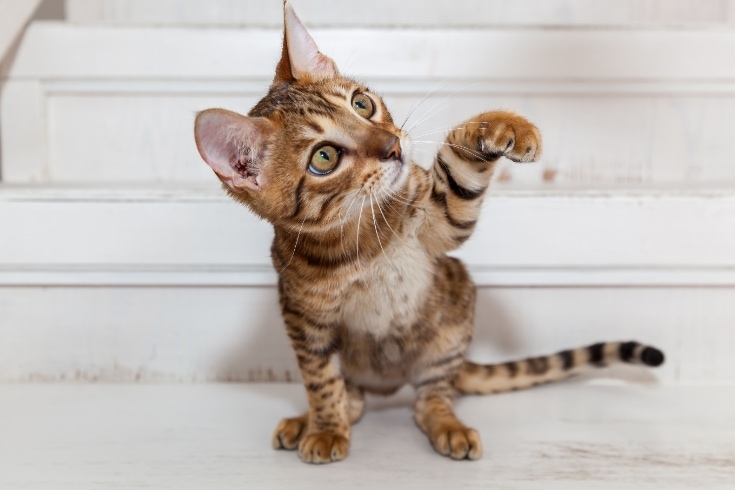Therapy cat training is all about preparing and teaching your cat to provide comfort, affection, and emotional support to people in hospitals, nursing homes, schools, care facilities, and even prisons. Unlike service animals that are trained to perform specific tasks for people with disabilities, therapy cats are taught to interact with people to provide them with psychological and emotional support.
Before you start training your cat to be a service pet, you will need to enroll in a suitable handler’s course. Assess your cat to ensure her temperament suits the role of a therapy cat, then train her in basic obedience using positive reinforcement therapy techniques.
Your cat must be exposed to many different environments, be comfortable being handled by different people, be well-socialized, and be happy to ride in her cat carrier. In addition, you’ll need to practice controlled visits with your cat, including various handling scenarios. During those visits, it’s helpful if your cat will walk on a harness and leash, especially in situations where there are pleasant gardens for residents and patients to enjoy in the company of a feline companion.
Finally, the relevant organization must certify your cat as a therapy pet, and there is a cost to that, which you should bear in mind. Many organizations nationwide offer therapy cat training certification to owners and their pets, so we recommend you conduct an internet search to locate providers in your area.
You’ll need to meet specific criteria, but these requirements differ depending on the certifying organization.
For example, with the Pet Partners program, it’s essential that your feline friend is at least a year old and has shared a home with you for a minimum of six months. It goes without saying that your cat should be friendly, without showing aggression towards people or other animals. However, some stipulations might surprise you. For example, cats on a raw protein diet aren’t eligible for most therapy cat programs. Additionally, it’s common for these training courses to insist on your cat being comfortable with a harness and leash, primarily for their safety.
The certification process typically begins with a preliminary screening questionnaire to gauge if you and your furry partner are the right fit. Once you’ve successfully met the basic qualifications, the next step usually involves undergoing training sessions tailored for either the handler alone or both the handler and the cat. After training, a hands-on evaluation for you and your pet is usually carried out by a skilled professional.
Once you’ve successfully completed all these stages, you’ll submit all the necessary documentation and a registration fee (the cost depends on the certifying body) to secure your position as a certified therapy team.
So, if you believe your cat has what it takes, why not consider this fulfilling path?
Read this guide to learn everything you need to know about therapy cat training!
What is a Therapy Cat, and How Does A Service Cat Provide Emotional Support?
A therapy cat is trained to provide comfort, affection, and companionship to people in settings such as hospitals, nursing homes, schools, and even some prisons. Therapy cats are usually part of animal-assisted therapy (AAT) or animal-assisted activities (AAA) and are used in a wide range of therapeutic settings to help people cope with stress, trauma, and other psychological or emotional challenges and conditions.
In contrast, “service cat” is a term less commonly used than “service dog.” Typically, cats are not used as service animals in the way that dogs or miniature horses might be to provide specific tasks for those with disabilities, such as guiding visually impaired people or alerting those with hearing impairments.
However, cats can be Emotional Support Animals, providing therapeutic benefits to their owners through their undemanding companionship and constant affection. Unlike service animals, ESAs are not trained to perform specific tasks related to the owner’s disability.
Companionship

Cats offer a unique form of companionship that’s both silent and comforting. Whether they’re curled up on your lap or purring beside you, they’re there, and that simple presence can be a warm reminder to someone suffering in distress that they’re not alone in this world.
Stress Reduction
It’s medically proven that just stroking a cat and listening to her rhythmic purring can significantly reduce anxiety and stress. It’s like having your very own living, breathing stress ball!
Routine and Responsibility
Cats love routine, and the daily schedule of feeding, grooming, and playing with a furry friend instills a sense of responsibility in us. That routine provides structure to your day and gives you a sense of purpose. After all, you can’t feel useless when a kitty relies on you, right?
Physical Touch
The sensation of soft fur under your fingers or a gentle head-butt from a feline friend is undoubtedly therapeutic. That’s because a pleasurable physical touch releases oxytocin, a chemical that’s often called the “love hormone,” which promotes feelings of love, bonding, and well-being. So, every time you cuddle your cat, you’re basically giving yourself a mini therapy session.
Distraction

When I’m feeling down or under the weather, I love to watch my cats chasing a laser dot or trying to catch butterflies in my garden. Those playful antics are not just entertaining; they serve as an ideal distraction from the everyday worries of life, offering a break from our routine thoughts and concerns.
Non-judgmental Presence
Unlike many people, cats don’t care about your bad hair day, the mistake you made at work, or that embarrassing thing you did five years ago that you can’t seem to forget.
They’re masters of living in the moment and offer a non-judgmental presence, silently telling you, “Hey, it’s okay. I love you.” And that makes a therapy cat the ideal companion for someone dealing with trauma or coming to terms with the raw grief of a bereavement.
Mindfulness and Mind-Body Connection
Watching a cat can provide a valuable lesson in mindfulness. Notice how your furry friend is completely engrossed when she’s watching a bird or feeling a warm breeze blowing through her fur?
Your cat teaches you to be present and to connect with your surroundings, and when you’re focused on your cat, you practice mindfulness without even trying.
Can a Cat Be a Service Animal?
No, a cat can’t be a service animal. The Americans with Disabilities Act (ADA) states that a service animal can only be a dog or a miniature horse.
So, can you train cats to become therapy pets? Yes! Although your feline friend can’t be a cat service animal, she could fulfill an equally important role as a cat therapist or Emotional Support Cat.
What Are the Differences Between a Therapy Dog and a Therapy Cat?
The differences between a therapy dog and a therapy cat aren’t as obvious as you might at first think!
Here’s an overview of how the two roles are different.
| Species | Therapy Dog – Canine | Therapy Cat – Feline |
| Social Nature | Generally very social. Dogs typically thrive on human interaction and are often friendly with strangers. | Typically more independent. Some cats are social, while others are more reserved. |
| Training and Certification | Dogs are often required to undergo specific training programs to become certified therapy dogs. Many organizations offer certification for therapy dogs. | Training is less common, but some organizations may offer guidance. It’s more about selecting cats with the right temperament. Certification is less standardized for cats. |
| Activities and Settings | Often found in hospitals, schools, nursing homes, and disaster areas. They provide comfort, perform support tasks, and can even assist in physical therapy. | Often used in settings where calmness and a gentle presence are required, like hospitals, nursing homes, and sometimes schools and prisons. |
| Requirements and Challenges | Need regular exercise, structured training, and grooming. Challenges can include managing the dog in settings with many distractions, potential allergies, or fears from individuals. | Require less maintenance in terms of exercise but need proper socialization to be comfortable in different settings. Challenges include potential allergies among individuals and the cat’s sensitivity to stressful environments. |
What Cat Breeds Are Good as Therapy Cats?
Therapy cats can be any breed, provided they are trainable, friendly, and remain calm in potentially stressful situations. However, it’s recognized by many training organizations that certain breeds of cats are more suited to a therapy role.
Here are some of the most popular therapy cat breeds and what makes these felines perfect for therapy.
Ragdoll
Ragdolls are often referred to as being like puppies because they follow their owners around and are incredibly affectionate. Their placid nature and loving temperament make these cats perfect companions for those needing emotional support.
Maine Coon
Main Coons are known as the “gentle giants” of the cat world, Their large size offers a substantial presence for individuals to connect with physically, and they’re known for their kind and even-tempered personalities.
Siamese

Siamese cats are well-known for being highly vocal, which can be comforting for people who live alone and seek companionship. The Siamese’s social and outgoing nature can help brighten the mood of everyone they interact with.
British Shorthair
The British Shorthair is renowned for its calm, stoical nature and can be a stable, comforting presence, easily forming a strong bond with those they’re assisting.
Birman
Birmans are gentle, affectionate characters that often form strong attachments to their owners. These kitties have soft, silky fur that you simply can’t help stroking!
Scottish Fold
Scottish Folds are easily recognized for their round faces and unique folded ears. These quirky cats are also known for their playful, easy-going nature and ability to adapt to new situations.
Abyssinian
Abyssinians are active, intelligent cats whose playful nature provides an ideal distraction and brings joy to those in therapeutic settings.
Siberian

Siberians are known for being excellent, affectionate pets for children. As an added bonus, these cats are less likely to trigger a reaction in those with pet allergies because of the type of protein they produce.
Norwegian Forest Cat
These cats are very gentle and patient, with thick, soft coats that provide sensory comfort and a calm demeanor that can offer emotional solace to those suffering from trauma and mental health challenges.
American Shorthair
American Shorthairs can fit into lots of different environments with ease. These gorgeous cats are typically good-natured and easygoing, offering stable companionship to those who need it.
What Are the Characteristics of a Good Therapy Cat?
Therapy cats need certain characteristics to make them a good fit for the role. Therapy cats that are gentle, well-socialized, and responsive to human emotions can be a great source of stress relief and promote a sense of well-being for those they interact with.
Consider the following ideal traits that make a good therapy cat and see if they describe your furry friend.
Temperament

A therapy cat must have a calm, even temperament. She must be able to comfortably handle diverse environments, noises, and the different personalities of the people she meets.
Friendly and Social
A therapy cat should be naturally friendly, approachable, and eager to be petted when interacting with strangers or in unfamiliar surroundings.
Adaptability
A good therapy cat should be flexible and adaptable in different environments and situations, and she should not be overly territorial or get upset by changes in her surroundings.
Patience
During therapy sessions, patients might sometimes handle the cat clumsily or unpredictably, so the cat must be patient and forgiving and not become irritable or bad-tempered.
Empathy
Although it’s not easy to measure, many therapy cat owners insist that their pets can intuitively sense when someone is distressed or needs comfort, making the cat approach and console the person.
Non-Aggressive

Therapy cats must be non-aggressive to ensure gentle and safe interactions, promoting trust and a soothing environment. However, being too reserved may limit engagement in some cases. This is a valuable trait in therapy cats.
Reliability
Cats must exhibit consistent calmness and predictability in their behavior. This allows individuals seeking comfort to have reliable and positive interactions, which maximizes the therapeutic benefits of their presence.
Physical Comfort
Everyone loves to cuddle and stroke a cat, and therapy cats must be comfortable being touched all over their bodies, being held (when appropriate), and sitting on laps for the longest time!
Grooming and Hygiene
A therapy cat must be well-groomed and kept free from parasites, with her nails regularly trimmed so that she’s pleasant to stroke and touch and cannot accidentally scratch someone.
Health and Vaccinations
Your therapy cat should have regular veterinary health checks to ensure she’s not suffering from any underlying health conditions.
Training and Commands

Although a therapy cat doesn’t require extensive training like a therapy dog does, she should still be obedient to basic commands and be leash-trained for her own safety and that of those to whom she provides comfort.
Interest in People
As well as being friendly and outgoing, a therapy cat should genuinely like and show an interest in people, hopping onto an inviting lap without being told to.
Low-Stress Tolerance
Although having a low-stress tolerance might sound counterintuitive for a therapy cat, it’s essential that your cat tells you when she is feeling stressed or overwhelmed by a situation. That way, you can remove your cat from a situation she finds distressing, both for her welfare and the safety of those around her.
What Are The Things You’ll Need For Therapy Cat Training?
You’ll need a variety of different things before you can start out on a therapy cat training journey with your beloved pet.
Here’s an overview of everything you’ll need to set you on the path to success!
Qualified Trainer or Program

First of all, you’ll need to contact a qualified trainer or find an organization that offers a training program in your area. Various organizations across the US offer training programs for would-be therapy cat duos, and a quick Google search is the way to go.
Suitable Cat
As mentioned earlier in this article, not every cat is a good fit for a therapy cat role, and a qualified trainer will assess your pet for suitability as a therapy cat before you sign up for a course.
Health and Veterinary Care
Your cat won’t be able to train and perform well as a therapy cat unless she’s in good health and fully vaccinated against dangerous diseases, so routine veterinary checkups are essential.
Positive Reinforcement Treats
When you start training your cat, you’ll need plenty of positive reinforcement treats to reward her when she does well.

Positive reinforcement means rewarding your cat when she responds correctly to a verbal cue. The cat learns to display a certain behavior to receive a tasty reward, making her more likely to repeat that behavior in the future.
Interactive Toys

Not every cat enjoys edible treats, and some prefer a game with an interactive toy as a reward for a job well done. Toys, such as laser pens and feather wands, are popular with many therapy cats and their trainers.
Harness and Leash

In some scenarios, it’s safer for your cat to walk on a harness and leash, and some facilities, such as senior care homes, have gardens residents enjoy. Teach your cat to walk on a leash so she can accompany her patients in safety.
Carrier

You’ll need to train your cat to accept being transported in a special carrier to make traveling to vet appointments and to visit those in need of therapy.
Socialization Opportunities
A therapy cat must get used to being in all kinds of environments and meeting lots of different people and animals. So, you’ll need to check out as many socialization opportunities as possible to prepare your pet.
Try visiting cat cafes, garden centers, and other pet-friendly places with your pet.
Quiet Space
You will need to set aside a quiet space in your home for your therapy cat training sessions, where you won’t be distracted or interrupted.
Patience and Consistency
Some cats learn more quickly and easily than others, so be patient and consistent and adjust the pace of your training sessions to suit your pet’s learning ability.
Documentation
When training a therapy cat, certain documentation is essential. You will need up-to-date health records, including vaccinations, and some programs require a health certificate from a veterinarian.
Outline your training methods, goals, and milestones to keep your training organized and measurable. You should also regularly record your cat’s progress, any setbacks, and Improvements during your training sessions to help refine your approach.
Permission and Visitation Agreements
Permission and visitation agreements are crucial to ensure that your therapy cat is welcomed in the facilities you intend to visit. These documents clarify expectations and responsibilities for all parties involved, so check with each venue before visiting to find out what paperwork they need.
How to Train a Therapy Cat
Training a cat as a therapy cat is a challenging but extremely rewarding undertaking, so congratulations if you’ve decided to start the process.
Here are some helpful tips on training your cat to be a therapy heroine!
Enrolling in a Handler’s Program
The first thing to do is enroll in a handler’s program. That will provide you with guidelines on how to train your cat, and you’ll finish up with a certification if you and your cat pass the course.
Assess Your Cat’s Temperament
Before you enroll in a handler’ course, you must assess your cat’s temperament to see if she’s suitable for a role as a therapy cat. Your course provider or your vet will be able to advise you more on your cat’s suitability.
Basic Obedience Training

Your cat must be obedient to basic commands and verbal cues before you can start training her to be a therapy cat. So, make a start on that as soon as possible.
Positive Reinforcement
You must use positive reinforcement when training your cat. Positive reinforcement means giving your cat a treat or a game with a favorite toy as a reward for displaying a desired behavior. That way, your cat learns that repeating the behavior in the future will get a pleasurable reward, making her more likely to behave as you want her to.
Desensitization to Handling
Therapy cats must get used to being handled by different people in different ways without becoming upset or stressed.
Exposure to Different Environments
As a therapy cat, your pet will be exposed to many different environments and surroundings, so you need to include that as part of your training program.
Socialization
Therapy cats must be extremely well-socialized and get along with other animals and strangers. So be sure to take your cat to places such as cat cafes, pet-friendly restaurants, and other environments where your cat can meet people in safety.
Positive Association with Carrier

Your cat must get used to visiting the vet for regular checkups and traveling to and from different venues, such as hospitals, old people’s homes, and schools. So, you need to train your cat to have a positive association with her carrier through positive reinforcement.
Practice Controlled Visits
It’s a good idea to practice controlled visits to places such as schools, care homes, and the like, where your cat can learn to meet and interact with people.
Practice Handling Scenarios
As previously mentioned, a therapy cat must be happy to sit on many different laps, be picked up, carried around, and stroked endlessly! So, as part of your cat’s training, you will need to practice handling scenarios, using your friends and family as guinea pigs.
Continue Training Gradually
Cats learn at different speeds, with some picking up training commands more quickly than others. Be prepared to continue your training gradually, and don’t try to push your cat to make progress faster than she is comfortable.
Certification and Organization Requirements
Therapy pet certification requirements vary depending on the training organization you use. However, most will want to assess your cat for suitability. You’ll need to have owned your cat for at least six months, and she must be at least one year old.
Your cat must never have shown any aggressive tendencies toward people or other animals, and some training providers will not allow cats who eat a raw protein diet to participate. Most training programs also insist that your cat can wear a leash and harness, primarily for your pet’s own safety.
The price of training courses and certification registration varies between providers. However, the average cost of a two-year registration with Purina is around $95.
Regular Review and Maintenance
To maintain your certification and therapy cat status, most organizations expect to carry out regular reviews of your cat and her performance in the field, and you might be required to carry out maintenance training tasks.
Of course, you should review your cat’s training and basic obedience on a regular basis and be sure to carry out any retraining she needs.
Conclusion
If you have a young, friendly cat who loves to spend time around people and doesn’t object to being handled, she might be a suitable candidate for a career as a therapy cat.
To train your cat to provide therapy for people who would benefit from companionship, emotional support, and unconditional affection, you will need to have your cat assessed by a therapy training organization. If your pet is deemed to be suitable for life as a therapy cat, you can embark on a training program.
Therapy animals do not carry out the same tasks as service animals, such as dogs and miniature horses. However, they can provide a lifeline to many lonely, isolated people and those recovering from trauma.
Do you think your cat has what it takes to become a therapy cat? Tell us about your pet and what makes you think she would be a good therapist in the comments box below.